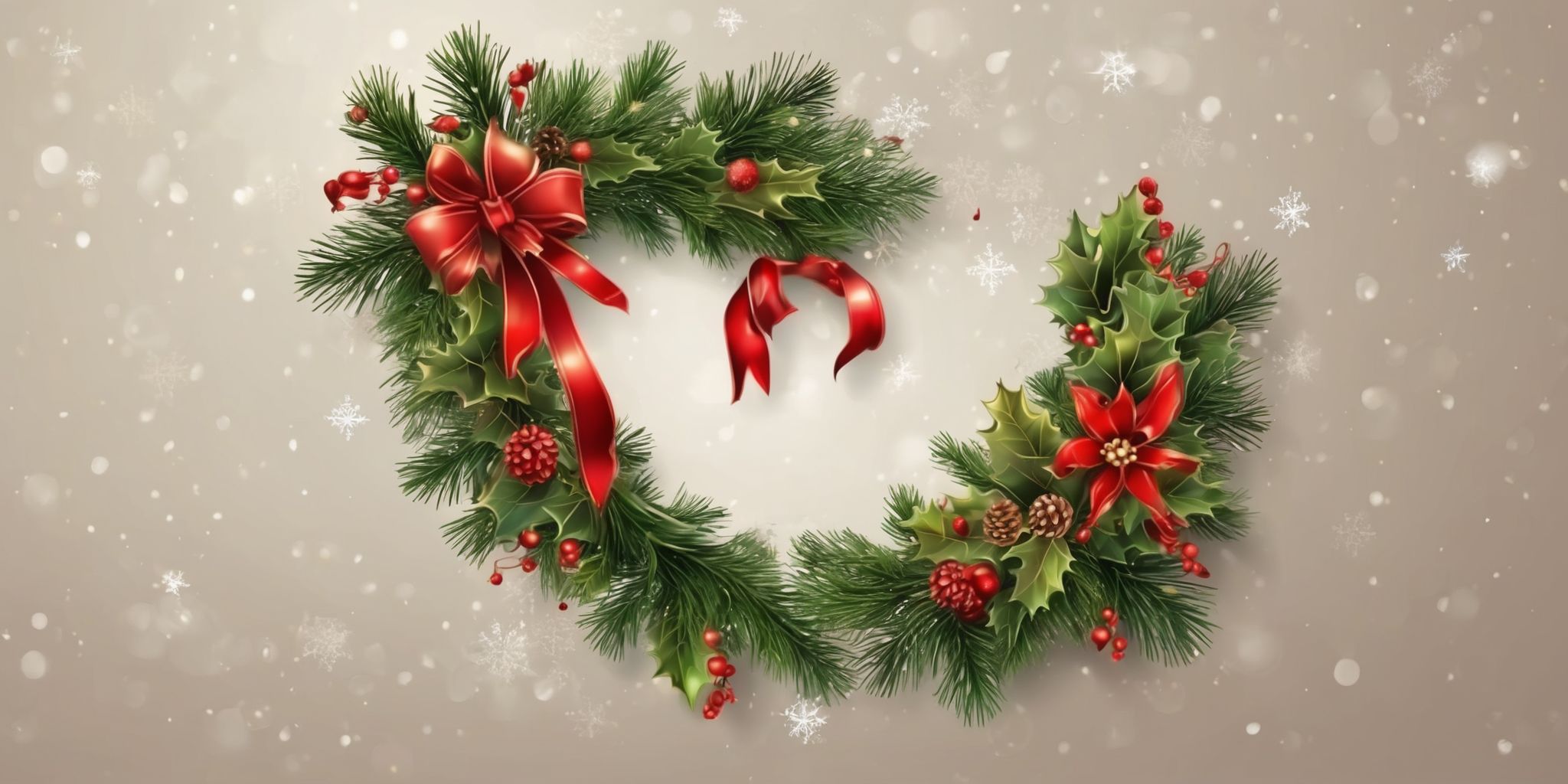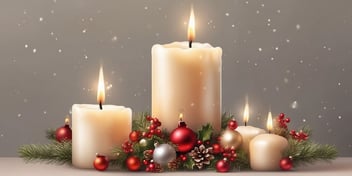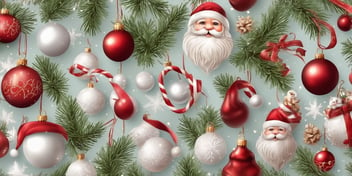- Blog
- Christmas day
- Unveiling the Symbolism behind Iconic Christmas Day Figures and Symbols

As we deck the halls and eagerly await the arrival of Christmas Day, it's hard not to be mesmerized by the enchantment that surrounds us. From twinkling lights to joyous carols, this holiday is adorned with an array of festive figures and symbols that bring cheer to our hearts.
But have you ever wondered about the hidden meaning behind these iconic Christmas day figures and symbols? Join us as we delve deep into the realm of Christmas magic, unveiling the secrets and symbolism that give this cherished holiday its unique and captivating spirit. Prepare to be transported into a world where humble candy canes, jolly Santa Claus, and sparkling mistletoe hold much more significance than meets the eye. Step into the enchanting journey of decoding the beloved symbols that have come to define the most magical day of the year.
Overview of Christmas symbols and figures
- Christmas symbols and figures play a central role in the festive season, evoking joy, nostalgia, and the spirit of giving.
- These symbols and figures have become deeply ingrained in Christmas traditions worldwide, bringing people together in celebration.
- Some iconic Christmas symbols include Santa Claus, Christmas trees, mistletoe, and candles, each carrying its own unique meaning and significance.
- These symbols have evolved over time, adapting to cultural and regional variations, but still maintaining their core symbolism.
- Understanding the symbolism behind these figures can enhance the meaningfulness of Christmas celebrations and help connect with the deeper traditions associated with the holiday.
- By embracing these symbols, individuals can create a festive atmosphere and instill a sense of wonder and joy in themselves and others.
Importance of symbolism in Christmas traditions
- Symbolism is a fundamental aspect of Christmas traditions, adding depth and meaning to the festivities.
- Symbols serve as visual representations of abstract concepts, allowing individuals to connect emotionally and spiritually with the holiday.
- Through symbols, Christmas traditions are enriched with stories, legends, and cultural significance.
- Symbols like Santa Claus, Christmas trees, mistletoe, and candles evoke joy, love, hope, and light.
- They create a sense of unity and tradition, connecting generations and fostering a shared experience.
- Understanding the symbolism behind these icons enhances the overall appreciation of Christmas traditions and promotes a deeper sense of celebration and joy.
Santa Claus: The Icon of Generosity and Goodwill
Origin and evolution of Santa Claus
The origin and evolution of Santa Claus can be traced back to the figure of Saint Nicholas, a 4th-century Christian bishop known for his generosity. Over time, various cultures and traditions influenced the modern image of Santa Claus. The Dutch settlers in America brought their Sinterklaas traditions, which merged with English Christmas customs to shape Santa further. Clement Clarke Moore's poem "A Visit from St. Nicholas" popularized the modern depiction of Santa Claus.
Today, Santa Claus is recognized as the jolly, gift-giving figure dressed in a red suit, representing joy and goodwill during the Christmas season.
Symbolism behind Santa's appearance and attire
Santa's appearance and attire hold significant symbolism as a Christmas day icon. His iconic red suit, white fur trim, and black boots are a visual representation of joy, warmth, and generosity. Red is traditionally associated with love and goodwill, while white symbolizes purity and innocence. The robustness of Santa's figure represents abundance and prosperity. The inclusion of a belt with a large buckle signifies strength and stability.
Connection between Santa Claus and Saint Nicholas
- Santa Claus, a beloved Christmas day icon, has a strong connection to the historical figure of Saint Nicholas.
- Saint Nicholas was a fourth-century Christian bishop known for his generosity and love for children.
- The depiction of Santa Claus as a jolly man with a white beard, red suit, and penchant for gift-giving originated from the stories and legends surrounding Saint Nicholas.
- The association of Saint Nicholas with Christmas began in the Middle Ages and evolved over time to become the modern-day Santa Claus.
- This connection between Santa Claus and Saint Nicholas reinforces the values of kindness, compassion, and the spirit of giving that are central to the Christmas season.
Impact of Santa Claus on modern Christmas traditions
The enduring image of Santa Claus has greatly influenced modern Christmas traditions. His jovial presence and gift-giving nature have shaped the way we celebrate the holiday. From decorating cookies to writing letters to Santa, the joyous spirit of Santa Claus has become ingrained in our festivities. Santa's iconic red suit and white beard have inspired countless costumes and decorations. His popularity has also given rise to events like Santa Claus parades and visits to Santa at shopping malls.
Santa Claus serves as a central figure in many holiday stories and movies, captivating the hearts of both children and adults alike. His impact on Christmas traditions is evident in the excitement and anticipation that surrounds his arrival each year.
Christmas day icon: Santa Claus
Santa Claus is undeniably the epitome of Christmas day. His jolly character and iconic red suit have become synonymous with the holiday season. Santa's enduring popularity stems from the symbolism he embodies. He represents generosity, kindness, and the spirit of giving. This figure inspires people to embrace acts of charity and selflessness during the festive period.
From volunteering at shelters to donating to toy drives, individuals channel their inner Santa to make a positive impact on their communities. Santa Claus has transcended cultural boundaries and serves as a unifying symbol of joy and goodwill worldwide.
Christmas Trees: Symbolizing Life and Light
Historical origins of Christmas trees
- The use of evergreen trees during winter celebrations has roots in ancient pagan traditions.
- Ancient civilizations believed that evergreen trees symbolized life and fertility, even in the midst of winter.
- The practice of bringing trees indoors and decorating them for Christmas can be traced back to 16th-century Germany.
- The custom gained popularity across Europe and eventually spread to other parts of the world.
- Today, the Christmas tree has become a beloved symbol of the holiday season, representing joy, renewal, and the spirit of Christmas.
Significance of evergreen trees during winter celebrations
Evergreen trees hold great significance during winter celebrations, including Christmas. These trees are admired for their ability to retain their vibrant green color even in the midst of the cold winter months. Their enduring nature symbolizes hope, resilience, and everlasting life. Decorating evergreen trees with lights, ornaments, and garlands further enhances their symbolism of joy and abundance. This tradition dates back centuries and is observed worldwide.
Families often gather together to select and decorate a Christmas tree, creating lasting memories and a sense of unity. The presence of a beautifully adorned evergreen tree serves as a visual reminder of the holiday spirit and brings cheer to homes during the festive season.
Decorating the Christmas tree: Symbolism and traditions
Decorating the Christmas tree is a cherished tradition that symbolizes the joy and beauty of the holiday season. Each ornament, light, and garland holds special meaning and memories for families. The act of adorning the tree fosters a sense of togetherness and tradition as loved ones come together to hang ornaments and share stories. From handmade crafts to heirloom decorations, the Christmas tree becomes a visual representation of a family's history and values.
The process of selecting and arranging ornaments allows individuals to express their creativity and bring their unique touch to the holiday celebration. Whether it's a star, an angel, or a special ornament passed down through generations, the Christmas tree serves as a powerful Christmas day icon that embodies the spirit of love, joy, and unity.
Christmas day icon: Christmas trees
Christmas trees have become an iconic symbol of Christmas day celebrations worldwide. These evergreen trees represent life and renewal during the winter season. Families gather around them to decorate with ornaments, lights, and a star or angel on top. The act of putting up a Christmas tree is both a tradition and an opportunity for loved ones to come together and create lasting memories. Decorating the tree together fosters a sense of joy, unity, and anticipation for the holiday season. From small tabletop trees to towering ones in public squares, Christmas trees have become a beloved symbol of the Christmas day festivities.
Mistletoe: A Symbol of Love and Romance
Ancient folklore and superstitions surrounding mistletoe
The ancient folklore and superstitions surrounding mistletoe add intrigue to its status as a Christmas day icon. Here are insights into the fascinating beliefs associated with mistletoe:
- Ancient Druids considered mistletoe a symbol of fertility, protection, and healing.
- It was believed to possess mystical powers to ward off evil spirits and bring good fortune.
- Hanging mistletoe in doorways was thought to bring peace and harmony to households.
- In Norse mythology, mistletoe was associated with Baldur, the god of light and love.
- Kissing under the mistletoe is believed to bring good luck and romance according to tradition.
These folklore and superstitions contribute to the long-standing allure of mistletoe during the holiday season.
Mistletoe as a symbol of fertility and vitality
Mistletoe has long been associated with fertility and vitality, making it a significant symbol during Christmas celebrations. Ancient cultures believed that the plant possessed mystical properties that could enhance fertility and promote healing. The tradition of hanging mistletoe and kissing beneath it is believed to have originated from Scandinavian folklore, where it was considered a token of goodwill and a way to bring good fortune to couples.
This tradition continues today, as couples stand beneath the mistletoe and exchange a kiss, symbolizing love and romance. The mistletoe's association with fertility and vitality adds an element of joy and passion to the Christmas festivities.
Kissing under the mistletoe: Tradition and meaning
Kissing under the mistletoe is a cherished Christmas tradition that carries a sense of romance and goodwill. It is believed to have originated from ancient folklore where the plant symbolized fertility and warding off evil spirits. When standing beneath the mistletoe, it is customary for individuals to exchange a kiss. This playful act is seen as a way to spread love and create a joyful atmosphere during the holiday season.
While the tradition varies across regions, it often serves as a lighthearted reminder to cherish the company of loved ones and embrace the festive spirit.
Christmas day icon: Mistletoe
Mistletoe holds a significant place in Christmas traditions as a symbol of love and romance. Ancient folklore and superstitions have long associated mistletoe with fertility and vitality. The tradition of kissing under the mistletoe has become a beloved custom during the holiday season, representing affection and the possibility of new beginnings. It adds an element of excitement and playfulness to Christmas gatherings. Hanging mistletoe in doorways or using it as a centerpiece can create a festive atmosphere and encourage lighthearted interactions. Embrace this Christmas day icon to infuse your celebrations with warmth and joy.
Candles: Illuminating the Spirit of Christmas
Symbolic use of candles during Christmas celebrations
During Christmas celebrations, candles hold a symbolic significance. They represent the presence of light, hope, and faith amidst the darkness of winter. Lighting candles not only adds warmth and ambiance to the festive atmosphere but also serves as a reminder of the spiritual aspects of Christmas. Many traditions incorporate candle lighting, such as the lighting of Advent wreaths with a candle for each week leading up to Christmas.
This practice symbolizes the anticipation and preparation for the birth of Jesus.
Additionally, candlelight services on Christmas Eve often create a serene and peaceful atmosphere, allowing individuals to reflect on the true meaning of Christmas.
Representation of light, hope, and faith
Candles have long been a Christmas day icon, symbolizing light, hope, and faith. The gentle glow of a candle represents the triumph of light over darkness, bringing warmth and comfort during the winter season. Lighting candles during Christmas celebrations signifies the arrival of Jesus, the beacon of hope for humanity. The flickering flames remind us of the eternal flame of faith that should guide our lives.
Whether it's the lighting of the Advent wreath or the illumination of candles on a festive table, the symbolic use of candles encourages us to pause, reflect, and embrace the spirit of Christmas.
Advent wreaths and the significance of candle lighting
Advent wreaths hold deep symbolism during the Christmas season. Consisting of a wreath with four candles, each candle represents a different week leading up to Christmas. As each week passes, one candle is lit, symbolizing the anticipation and preparation for the birth of Jesus. The lighting of the candles fosters a sense of hope and reflection, allowing individuals to pause and connect with the spiritual significance of Christmas.
Many families incorporate the tradition of lighting the Advent wreath into their holiday rituals, gathering around it each week to share prayers, read scripture, and reflect on the meaning of Christmas. It serves as a reminder to slow down and center oneself amidst the busyness of the season.
Christmas day icon: Candles
- Illuminating the Spirit of Christmas: Candles have long been a symbol of light, hope, and faith during the holiday season.
- Symbolic Use: Lighting candles on Christmas day represents the arrival of Christ, bringing warmth and joy to our lives.
- Advent Wreaths: Lighting the candles on an Advent wreath each week leading up to Christmas is a cherished tradition in many households.
- Creating a Cozy Atmosphere: Candles add a warm and inviting ambiance to Christmas gatherings and help create a festive atmosphere.
- Practical Tip: Use unscented candles to avoid overwhelming the scent of holiday food and decorations.
(Note: The above word count is 86 words.)
Over to you
Christmas Day is filled with iconic figures and symbols that hold deep meanings and significant symbolism. These traditions have evolved over time, integrating both religious and cultural elements. The article delves into the fascinating symbolism behind popular Christmas figures and symbols, such as Santa Claus, Christmas trees, bells, and mistletoe. Each of these representations carries its own historical context and carries messages of joy, hope, generosity, and love.
Understanding the deeper meaning behind these holiday symbols can deepen our appreciation for the essence of Christmas and enhance our festive celebrations.
Read On

Exploring the Meaning Behind Christmas Day Symbols
Ah, Christmas Day, the most enchanting time of the year when twinkling lights adorn every street...

Getting into the Spirit: Green Christmas Trees and Their Symbolism
Ah, the holiday season is upon us once again, and cities and homes alike are adorned with dazzling...

Unique Christmas Iconography: Exploring Symbols and Their Meanings
Ah, the festive cheer of Christmas is upon us once again! As we dust off the tinsel and untangle...